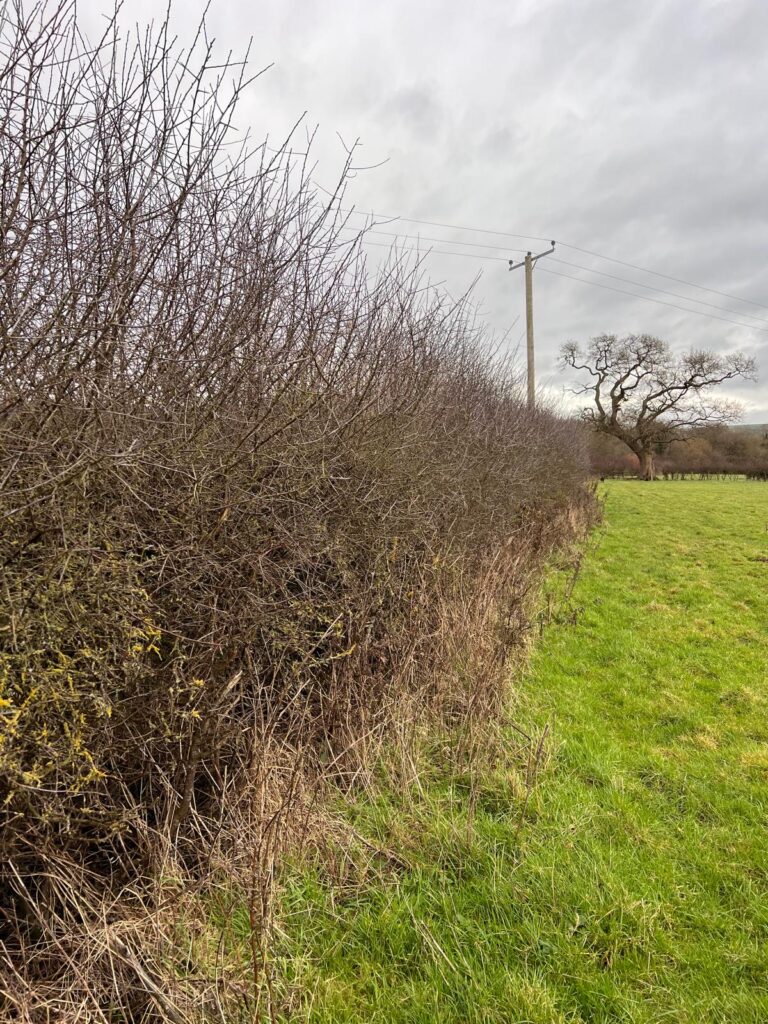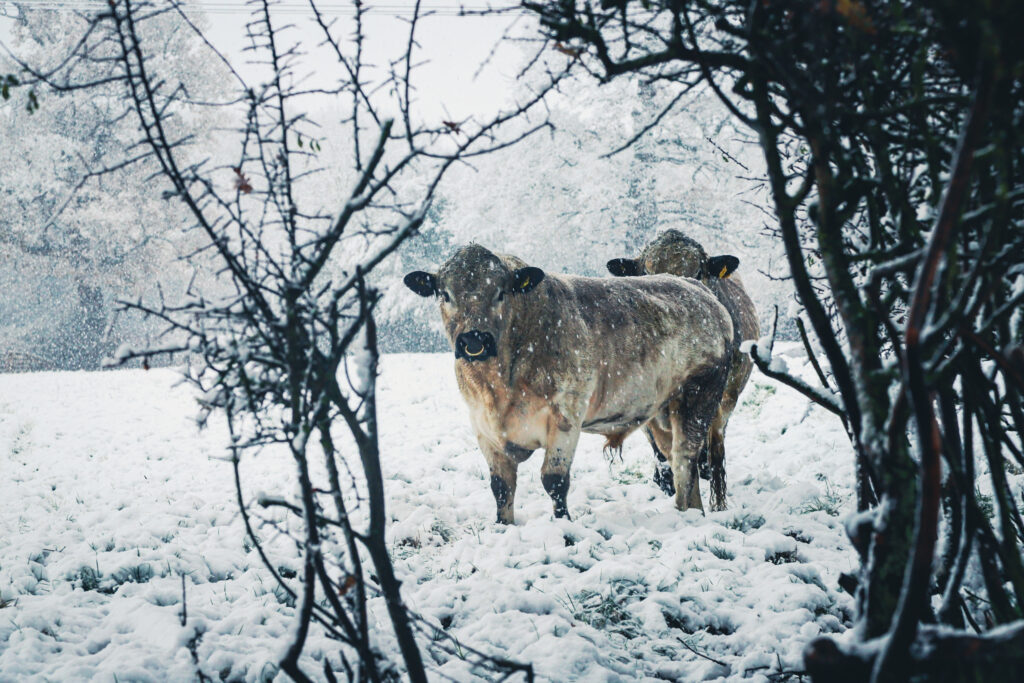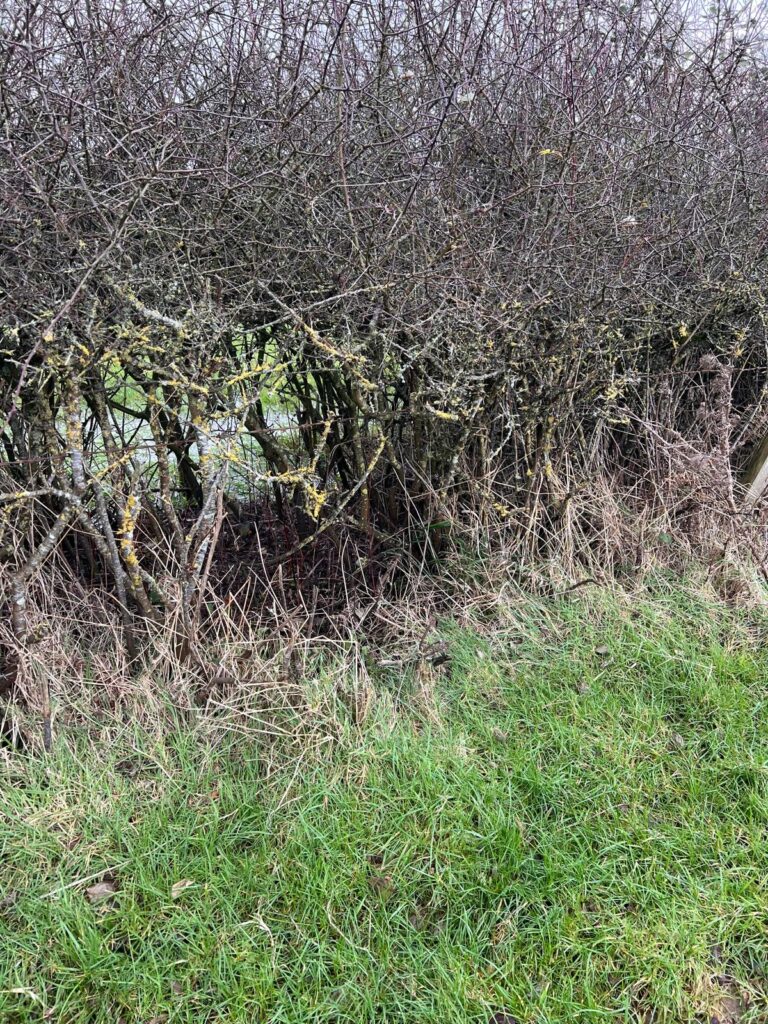Hedgerows have been an integral part of the British countryside for centuries. These dense, often thorny barriers of trees, shrubs, and plants mark the boundaries of fields, roads, and properties, offering a rich tapestry of biodiversity. But beyond their aesthetic charm, hedgerows provide a wealth of environmental, economic, and agricultural benefits, making them a key feature of sustainable farming in the UK.
In the last 75 years, more than half of British hedgerows have been lost and 42% of what remains is either ancient or species-rich. The ancient hedgerows are defined as those which were in existence before the Enclosure Acts (passed mainly between 1720 and 1840 in Britain) and species-rich hedges contain five or more native woody species on average in a 30-metre length, or four or more in northern England, upland Wales and Scotland. These hedgerows are the most valuable from an ecological perspective.
 Across the 120 acres we manage on the Wales-Shropshire border, there were over 5 miles of existing hedgerows. It was clear that though many hedges were present, they had not been well managed for some time, with cycles of excessive flailing (mechanical cutting) and then periods of uncontrolled growth. A commitment was made to learn more about management practices that promote thriving hedges that would be healthy enough to survive for generations to come. Blackthorn and hawthorn make up the majority of the existing hedgerows so a programme of ‘establishment’ planting new lengths of hedgerows and ‘gapping -up’ filling spaces where old plants had died, with a wider variety of species, was initiated. This will help to connect existing wildlife corridors and provide the higher value biodiverse ecosystems that species-rich hedgerows can provide.
Across the 120 acres we manage on the Wales-Shropshire border, there were over 5 miles of existing hedgerows. It was clear that though many hedges were present, they had not been well managed for some time, with cycles of excessive flailing (mechanical cutting) and then periods of uncontrolled growth. A commitment was made to learn more about management practices that promote thriving hedges that would be healthy enough to survive for generations to come. Blackthorn and hawthorn make up the majority of the existing hedgerows so a programme of ‘establishment’ planting new lengths of hedgerows and ‘gapping -up’ filling spaces where old plants had died, with a wider variety of species, was initiated. This will help to connect existing wildlife corridors and provide the higher value biodiverse ecosystems that species-rich hedgerows can provide.
In recent years, there has been a renewed interest in preserving and enhancing hedgerows on farms, driven by growing concerns about biodiversity loss, soil degradation, and the impacts of climate change. Some of the incredibly valuable features of British hedgerows are provided below.
Rural History
Hedgerows are not only valuable from an ecological and agricultural perspective, but they also have cultural and aesthetic significance. Many hedgerows in the UK are centuries old and are considered important features of the landscape, contributing to the distinct character of the countryside. They provide a sense of place and continuity, as well as offer opportunities for recreation, such as walking and birdwatching. Hedgerows are integral to local heritage, with many associated with traditional farming practices. In some regions, hedgerows are even part of local folklore, and their preservation is seen as a way to maintain cultural identity and connections to the land. The oldest hedge in Britain is located in Cambridgeshire, named the Judith hedge it is over 900 years old.
Biodiversity
Hedgerows are often referred to as the “lifeblood” of farmland wildlife. They provide vital habitats for a wide range of species, from birds and mammals to insects and plants. The tangled branches, dense foliage, and varied structure of hedgerows create the perfect environment for nesting birds like robins, blackbirds, and warblers, while also offering shelter for small mammals such as hedgehogs and voles.
Hedgerows support a wide variety of pollinators, including bees, butterflies, and moths, which are crucial for the pollination of crops and wild plants. In fact, a well-managed hedgerow can act as a crucial wildlife corridor, linking fragmented habitats and enabling species to move safely across the landscape.
Soil
One of the most significant environmental benefits of hedgerows is their role in preventing soil erosion. Hedgerows act as natural windbreaks, reducing the force of wind across fields and preventing soil from being blown away. In areas prone to flooding, hedgerows can help to absorb excess rainfall and reduce surface water runoff.
The roots of hedgerow plants also help to bind the soil together, reducing the risk of erosion during heavy rainfall. This is particularly important on sloping land, where erosion can quickly deplete topsoil and lead to significant losses in soil fertility. The increase in soil temperature, sometimes of up to six degrees, during winter provided by hedgerows allows for extended growing periods and easier grazing conditions.
Carbon
As the world grapples with the effects of climate change, hedgerows have emerged as important carbon sinks. The plants that make up hedgerows capture and store carbon dioxide from the atmosphere, helping to offset the greenhouse gases produced by farming and other human activities.
Research suggests that hedgerows can sequester significant amounts of carbon, especially when they are properly managed and allowed to grow to their full potential. In addition to reducing atmospheric carbon, hedgerows can also create microclimates that help to regulate temperatures on farms, providing a buffer against extreme weather events like heatwaves and frosts.
Pests
Hedgerows can also play a role in pest and disease management on farms. By providing a habitat for beneficial insects, such as ladybirds, predatory beetles, and spiders, hedgerows can help to control pests that might otherwise damage crops. These natural pest control methods are a valuable alternative to chemical pesticides, which can have negative effects on both the environment and human health.
Furthermore, hedgerows can act as a physical barrier against the spread of certain diseases. For example, they can help prevent airborne plant pathogens from moving between fields, offering an additional layer of protection for crops.

Livestock
The benefits hedgerows provide livestock cannot be overstated. Whether it be shade from the sun, refuge from strong winds or heavy rain, these natural buffers can effectively increase livestock resilience to extremes of temperature, with dry cattle thriving in temperatures 15 degrees lower than those with wet coats. This leads to happier, healthier animals that are more resistant to disease and more efficient t growth. Given the reducing predictability of the British climate, hedgerows are an essential component to farming livestock sustainably.
Water Quality
Hedgerows can play an important role in protecting water quality by acting as buffer zones between farmland and watercourses. The dense vegetation helps to filter out pollutants like nitrates, phosphates, and pesticides before they can reach rivers, streams, or groundwater sources. This helps to prevent water pollution and ensures that surrounding ecosystems remain healthy.
The filtration provided by hedgerows also contributes to maintaining the health of aquatic life, which can be crucial for farmers who rely on water sources for irrigation, livestock, or crop production.
Hedgerows are far more than just charming features of the British countryside. They offer a wide range of benefits to farms, including enhancing biodiversity, protecting soil, sequestering carbon, and improving farm productivity. By investing in hedgerows, we can not only contribute to environmental sustainability but also improve the long-term resilience of their operations.
With increasing pressures on farmland to meet the challenges of climate change and biodiversity loss, hedgerows represent a vital, natural infrastructure that supports both the environment and the economy. As we look to the future of farming, protecting and expanding our network of hedgerows will be crucial in ensuring a sustainable and productive agricultural landscape for generations to come.

